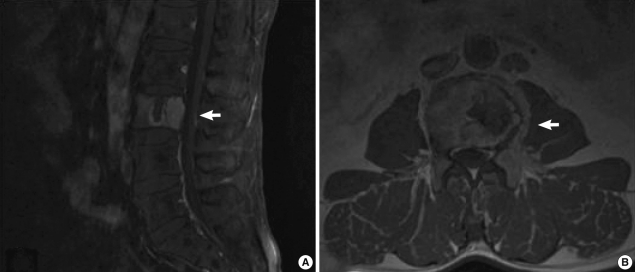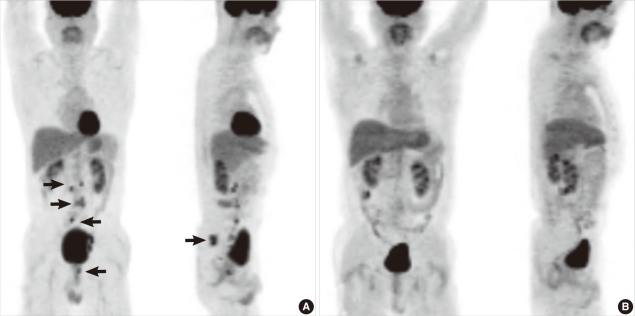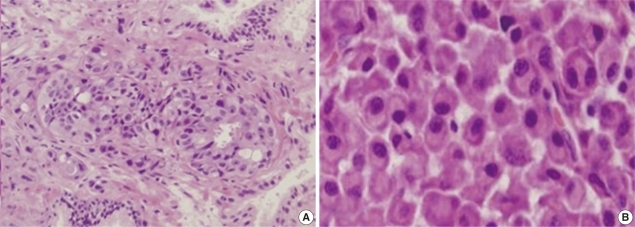Korean J Lab Med.
2011 Oct;31(4):285-289. 10.3343/kjlm.2011.31.4.285.
Multiple Myeloma with Biclonal Gammopathy Accompanied by Prostate Cancer
- Affiliations
-
- 1Department of Internal Medicine, Eulji University Hospital, Daejeon, Korea. lee982023@eulji.ac.kr
- 2Department of Laboratory Medicine, Eulji University Hospital, Daejeon, Korea.
- 3Department of Radiation Oncology, Eulji University Hospital, Daejeon, Korea.
- KMID: 1781694
- DOI: http://doi.org/10.3343/kjlm.2011.31.4.285
Abstract
- We report a rare case of multiple myeloma with biclonal gammopathy (IgG kappa and IgA lambda type) in a 58-year-old man with prostate cancer who presented with lower back pain. Through computed tomography (CT) imaging, an osteolytic lesion at the L3 vertebra and an enhancing lesion of the prostate gland with multiple lymphadenopathies were found. In the whole body positron emission tomography-computed tomography (PET-CT), an additional osteoblastic bone lesion was found in the left ischial bone. A prostate biopsy was performed, and adenocarcinoma was confirmed. Decompression surgery of the L3 vertebra was conducted, and the pathologic result indicated that the lesion was a plasma cell neoplasm. Immunofixation electrophoresis showed the presence of biclonal gammopathy (IgG kappa and IgA lambda). Bone marrow plasma cells (CD138 positive cells) comprised 7.2% of nucleated cells and showed kappa positivity. We started radiation therapy for the L3 vertebra lesion, with a total dose of 3,940 cGy, and androgen deprivation therapy as treatment for the prostate cancer.
MeSH Terms
-
Adenocarcinoma/complications/*diagnosis/radiotherapy
Antineoplastic Agents/therapeutic use
Bone Marrow Cells/metabolism/pathology
Combined Modality Therapy
Humans
Immunoelectrophoresis
Immunoglobulin kappa-Chains/blood
Immunoglobulin lambda-Chains/blood
Male
Middle Aged
Multiple Myeloma/complications/*diagnosis/drug therapy
Neoplasm Staging
Positron-Emission Tomography
Prostatic Neoplasms/complications/*diagnosis/radiotherapy
Spine/pathology
Syndecan-1/metabolism
Tomography, X-Ray Computed
Figure
Reference
-
1. Rajkumar SV. Multiple myeloma: 2011 update on diagnosis, risk-stratification, and management. Am J Hematol. 2011; 86:57–65. PMID: 21181954.
Article2. Kyle RA, Robinson RA, Katzmann JA. The clinical aspects of biclonal gammopathies. Review of 57 cases. Am J Med. 1981; 71:999–1008. PMID: 6797297.3. Kao J, Jani AB, Vijayakumar S. Is there an association between multiple myeloma and prostate cancer? Med Hypotheses. 2004; 63:226–231. PMID: 15236779.
Article4. Huang E, Teh BS, Saleem A, Butler EB. Recurrence of prostate adenocarcinoma presenting with multiple myeloma simulating skeletal metastases of prostate adenocarcinoma. Urology. 2002; 60:1111. PMID: 12475684.
Article5. Terris MK, Hausdorff J, Freiha FS. Hematolymphoid malignancies diagnosed at the time of radical prostatectomy. J Urol. 1997; 158:1457–1459. PMID: 9302142.
Article6. Knobel D, Zouhair A, Tsang RW, Poortmans P, Belkacémi Y, Bolla M, et al. Prognostic factors in solitary plasmacytoma of the bone: a multicenter Rare Cancer Network study. BMC Cancer. 2006; 6:118. PMID: 16677383.
Article7. Mahto M, Balakrishnan P, Koner BC, Lali P, Mishra TK, Saxena A. Rare case of biclonal gammopathy. IJCRI. 2011; 2:11–14.
Article8. Kahr WH, Al-Homadhi A, Meharchand J, Bailey DJ, Stewart AK. Testicular plasmacytoma following chemical orchiectomy: potential role of hypogonadism in myeloma proliferation. Leuk Lymphoma. 1998; 28:437–442. PMID: 9517517.
- Full Text Links
- Actions
-
Cited
- CITED
-
- Close
- Share
- Similar articles
-
- A Case of Multiple Myeloma with Biclonal Gammopathy
- A Case of Multiple Myeloma with Biclonal Gammopathy
- A Case of Multiple Myeloma with Biclonal (IgG-K and IgA-K) M-proteins
- A Case of Lymphoplasmacytic Lymphoma/Waldenström's Macroglobulinemia with IgM-κ and IgA-λ Biclonal Gammopathy
- Clinical Application of (18)F-FDG PET in Multiple Myeloma






